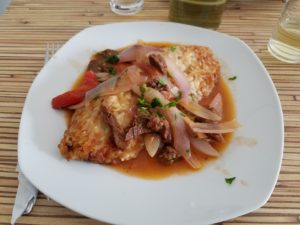
I ordered a tacu tacu–a version of refried beans and rice–and talked to the waitress Estephanie about it.
One theory says that tacu tacu began among enslaved Afro-Peruvians who figured out how to make use of food waste. Chronicles suggest that grandmothers would prepare it for breakfast using left-overs from the previous night’s dinner. Some theorize, however, that the dish has Quechua origins.
There are many ways to eat tacu tacu, Estefanie told me. While it’s usually made with Canary beans, sometimes it is made with lima beans or lentils. It’s sometimes eaten alongside bacon, fried eggs, or seafood, and sometimes these sides are mixed into the tacu tacu itself. Estefanie told me that tacu tacu, like the lomo saltado, is often cooked in a wok. This is an example of the extensive Chinese influence on Peruvian cuisine.
Since I was eating at an all-vegan restaurant, the dish was fried in vegan butter and was served with soy steak strips instead of animal-based meat. soy meat instead of animal-based meat. Sauteed onions and peppers were also included.